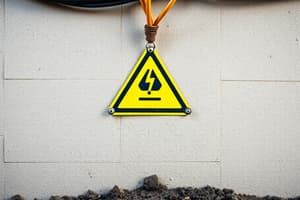Podcast
Questions and Answers
What is the primary reason for seeking medical attention after an electrical shock, even if the victim appears to recover fully?
What is the primary reason for seeking medical attention after an electrical shock, even if the victim appears to recover fully?
- To rule out external injuries
- To document the incident for insurance purposes
- Electrical shocks can cause internal injuries that may not be immediately apparent (correct)
- To receive a medical bill for services
Which safety measure is crucial to install in areas prone to moisture to prevent electrical shocks?
Which safety measure is crucial to install in areas prone to moisture to prevent electrical shocks?
- Voltage regulators
- Surge protectors
- Circuit breakers
- Ground Fault Circuit Interrupters (GFCIs) (correct)
Which of the following is NOT a recommended practice when dealing with electrical equipment?
Which of the following is NOT a recommended practice when dealing with electrical equipment?
- Working with electrical devices while standing on a wet surface (correct)
- Wearing insulated gloves
- Educating others about electrical safety
- Inspecting electrical devices regularly
What should be done immediately after an electrical shock incident?
What should be done immediately after an electrical shock incident?
Why is regular maintenance of electrical installations important?
Why is regular maintenance of electrical installations important?
What is the primary function of a miniature circuit breaker (MCB)?
What is the primary function of a miniature circuit breaker (MCB)?
Which component is used for measuring energy consumed by an electric load?
Which component is used for measuring energy consumed by an electric load?
What do the indicators in a distribution board signify?
What do the indicators in a distribution board signify?
What is the typical range of current values for Miniature Circuit Breakers (MCB)?
What is the typical range of current values for Miniature Circuit Breakers (MCB)?
How does a fan regulator control the speed of a motor or fan?
How does a fan regulator control the speed of a motor or fan?
Flashcards are hidden until you start studying
Study Notes
Electrical Safety
- Keep the victim comfortable and warm until help arrives.
- Monitor their breathing and pulse continuously.
- Inspect the area and equipment involved after an incident.
- Prevent future occurrences through corrective actions.
- Educate others about electrical safety and proper equipment handling.
- Wear protective gear like insulated gloves and shoes when working with electrical equipment.
- Install Ground Fault Circuit Interrupters (GFCIs) in moisture-prone areas for shock prevention.
- Regularly maintain all electrical installations and devices by qualified professionals.
- Even if the victim appears to recover fully, seek medical attention as electrical shocks can cause internal injuries.
Earthing Resistance Measurement
- For Pipe earthing, the resistance (R) is measured using a device called DECT.
- For Plate earthing, the resistance (R) is also measured using a DECT.
Earthing Significance
- Earthing provides a path to ground for any fault current, preventing dangerous electrical shock.
- It also protects electrical appliances from damage by channeling excess current to the ground.
Electrical Shock Response
- Immediately disconnect the power source.
- If the victim is still in contact with the source, use a non-conductive material to move them away.
- If breathing or heartbeat is absent, perform CPR.
- Seek immediate medical attention.
Personal Protective Equipment (PPE)
- Insulated gloves and shoes
- Eye protection
- Hard hat
- Non-conductive tools
Single-phase Energy Meter
- Measures the energy utilized by an electric load.
- Energy is calculated as the total power consumed over a specific time period.
- Used in domestic and industrial AC circuits for measuring power consumption.
- Calibrated in units like kilowatt-hours (kWh).
- Electric utilities use them for billing and monitoring purposes.
Miniature Circuit Breaker (MCB)
- An electromagnetic device that automatically breaks a circuit when current exceeds a set limit.
- Available as single-pole (SP) and double-pole (DP) types.
- Provides overload protection.
Components of House Wiring
- Distribution Board (DB Box): Divides the electrical feed into subsidiary circuits and provides protection for each circuit
- Indicator: Shows the status of the supply (glowing indicates supply is present)
- Socket and Plug: Used for connecting electrical appliances
- Fan Regulator: Regulates the speed of a fan or motor by adjusting the voltage applied to it
- Holder: Holds a light bulb or lamp securely
House Wiring Procedure
- Connect color-coded wires (red - phase, black - neutral, green - earth) according to the circuit diagram.
- Use a tester to verify connections throughout the circuit.
- Connect different room switch boards and loads to the DB Box once the main connection is complete.
- Ensure all loads function properly after applying the supply.
- Test the functionality of Residual Current Circuit Breaker (RCCB) and MCB under various conditions.
House Wiring Observations
- Measure voltage at all levels of the circuit and record the data.
- Calculate the loads connected for each house.
- Monitor the energy consumption using the energy meter and verify through manual calculations.
House Wiring Discussion
- Lighting circuits are used for lighting fixtures, while power circuits are used for appliances that require higher current.
- Adhere to primary electrical safety standards and codes for residential wiring.
- Improve energy efficiency through measures like using energy-efficient appliances and LED lighting.
- Routine maintenance includes checking for loose wiring, inspecting the condition of insulation, and testing circuit breakers.
- Select appropriate circuit breakers and fuses based on the size (amperage) of the circuit and the load it will handle.
Digital Measuring Equipment
- Voltmeter: Measures electric potential difference between two points in a circuit; connected in parallel.
- Ammeter: Measures the current in a circuit; connected in series.
- Wattmeter: Measures the power consumed by a load.
- Energy Meter (kWh): Measures the total energy consumed over time.
Energy Consumption Calculation
- Meter Reading: Record the initial and final meter readings to determine consumption.
- Tariff Structure: Energy tariff rates vary based on consumer category (residential, commercial, industrial) and consumption levels.
- Calculate Cost:
- Multiply units consumed in each slab by the corresponding tariff rate.
- Add fixed charges, additional charges, taxes, and duties (if applicable) to find the total bill.
Electricity Bill Calculation Example
- Present Registered Unit (kWh): Current meter reading
- Previous Registered Unit (kWh): Previous meter reading
- Minimum Fixed Charge: Usually a monthly charge, regardless of consumption.
- Energy Charges: Charges based on the units consumed (kWh).
- Electricity Duty: A tax on electricity consumption.
Studying That Suits You
Use AI to generate personalized quizzes and flashcards to suit your learning preferences.




